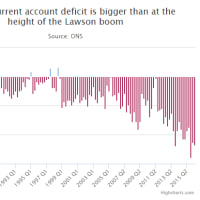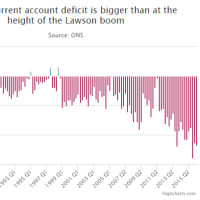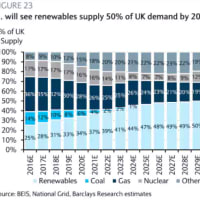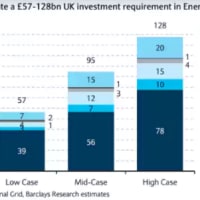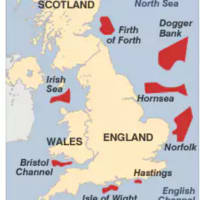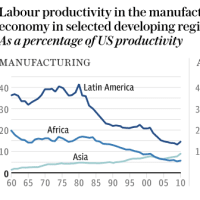ブレアもブラウンもその他の雑魚も揃って床を転げてワフワフ言ってた理由(笑)。
アヘン戦争の仕返しを徹底的にされるまではワフワフ言い続けるかもね。
キャメロンになってもかわらんだろうなあ。
こーやってワフワフして中国人民じゃなくって中狂をウハウハ言わせる続けてると、イギリスの惨禍も益々悪化する気がするのであるが…どうよ。
China and Britain ready to exploit Tibet's natural resources
(中国とイギリス、チベットの天然資源利用準備完了)
David Eimer
Telegraph:26/07/2008
アヘン戦争の仕返しを徹底的にされるまではワフワフ言い続けるかもね。
キャメロンになってもかわらんだろうなあ。
こーやってワフワフして中国人民じゃなくって中狂をウハウハ言わせる続けてると、イギリスの惨禍も益々悪化する気がするのであるが…どうよ。
China and Britain ready to exploit Tibet's natural resources
(中国とイギリス、チベットの天然資源利用準備完了)
David Eimer
Telegraph:26/07/2008
Despite political tensions in the country, its huge deposits of gold and other metals are proving too big a temptation for foreign miners, David Eimer reports from Beijingつづく
中国での政治的緊張感にも拘らず、埋蔵される莫大な量の金やその他の鉱物資源は、海外の鉱業会社にも抗い難い魅力を放っている。
While Britain's athletes are eyeing gold medals at the Beijing Olympics, British mining companies are setting out to claim a share of China's vast gold deposits. The resource-rich, soon-to-be superpower has been increasingly attracting the attention of foreign miners in recent years. Now, British firms are leading the race to develop the country's mineral deposits.
イギリス人アスリートが北京オリンピックの金メダルを狙う一方、イギリスの鉱業会社は中国の莫大な金鉱床の分け前を要求しようとしている。
資源が豊富で近々超大国となろうとする国への、海外の鉱業会社からの注目は、近年益々強くなっている。
今、中国の鉱床開発競争を主導しているのは、イギリス企業だ。
They are doing so a long way from the shiny new Beijing that will be on display to the world next month. While China has spent an estimated £20m readying the Chinese capital for the Olympics, it is to Tibet, one of China's least-developed regions, that foreign mining companies are now looking. Despite having one of the most hostile environments imaginable, as well as a serious lack of infrastructure, the "roof of the world" is a treasure trove of minerals.
これらの企業は、来月世界に向けてお披露目される、きらびやかな新生北京から遠く離れた場所で競争を繰り広げている。
中国は北京オリンピックの準備に£2,000万とも言われる金額を費やしたが、海外の鉱業会社が今目をつけているのは、中国で最も開発の遅れた地域の一つであるチベットだ。
インフラが酷く不足している他、最も過酷な環境の一つである「世界の屋根」は、天然資源の宝庫なのだ。
Central China Goldfields (CCG) is the only British miner operating in Tibet. Despite the recent protests against Chinese rule, it is adamant it has made the right decision.
CCGはチベットで活動する唯一のイギリス系鉱業会社だ。
先日、中国の支配に反対して勃発した抗議運動にも拘らず、同社は正しい決断を下したとの主張を崩していない。
"We're not a political organisation - we don't take sides. But whoever is in charge will develop these deposits," Jeff Malaihollo, the managing director of CCG, told The Sunday Telegraph. "It is how you do it that is important - whether you do it in an environmentally sustainable way and by working with the local community. Ultimately, though, if we don't do it, someone else will."
「うちは政治組織じゃない。どっちの味方もしない。誰でも関係ない。この鉱床を開発する責任者の味方だ」とCCGの代表取締役Jeff Malaiholloはサンデー・テレグラフ紙に語った。
「どうやってやるかが重要なんだ。環境的に持続可能な方法で、地元のコミュニティと協力してやるのかどうか。とはいえ、つまるところ、我々がやらなきゃ他の誰かがやるってことさ」。
There is no doubt about that. The once under-developed and under-funded Chinese mining sector is undergoing a revolution that in the next few years seems certain to have a profound effect on commodity markets worldwide. China is on its way to becoming self-sufficient and ultimately one of the world's major exporters of commodities, as vast new mineral deposits are discovered.
それについて疑問の余地はない。
かつては開発が遅れ資金も不足していた中国鉱業部門は、改革の真っ最中だ。
今後数年間、それが世界中の一次産品市場に大変な影響をもたらすことは確実だろう。
莫大な埋蔵量を持つ鉱床が新たに発見される中、中国は自給自足への道を、そして最終的には世界の主要一次産品輸出国の一つになる道を進んでいる。
Last year, China overtook South Africa to become the world's leading gold producer. Leyshon Resources, listed on Aim and the Australian Securities Exchange, is developing a gold mine in north-eastern Heilongjiang province. "China had a unique combination of untapped exploration potential and established infrastructure," said Paul Atherley, the managing director of Leyshon. "Because of that, China has become the world's largest gold producer in less than a decade."
昨年、中国は南アフリカを追い越して世界第1位の金産出国となった。
AIMとオーストラリア証券取引所に上場するLeyshon Resourcesは、北東部の黒龍江省で金鉱を開発している。
「中国には開発されていない試掘鉱床と確立されたインフラというユニークな組み合わせがある」Leyshonの代表取締役Paul Atherleyが言った。
「そのせいで10年も経たない内に、中国は世界最大の金産出国になった」。
British mining firms led the way into China. In 1997, the London-based, Aim-listed Griffin Mining became the first foreign company to be granted an exploration licence since the founding of the People's Republic of China in 1949. Now, British companies are operating across China and most are watching developments in Tibet, mining's new frontier.
中国へ先陣を切って乗り込んだのはイギリスの会社だ。
1997年、ロンドンに本社を置くAIM上場企業のグリフィン・マイニングは、1949年の中華人民共和国建国以来、初めて試掘許可を取得した外資系企業となった。
今、イギリス企業は中国全土で事業活動を行っており、その殆どは新たな鉱業開拓地であるチベットでの展開を鵜の目鷹の目で見守っている。
The Chinese name for Tibet, Xizang or "western treasure house", makes clear how valuable the volatile, politically sensitive region is to China. In 1999, the Chinese embarked on a secret, seven-year geological survey that found 16 major deposits of copper, iron, lead, zinc and other minerals. Tibet is believed to hold as much as 30m-40m tons of copper, 40m tons of lead and zinc and more than a billion tons of high-grade iron ore.
チベットの中国名、西蔵(シーツァン)または「西の宝の蔵」は、この不安定で政治的にデリケートな地域が、中国にとってどれほど価値のあるものかを明確にしている。
1999年、中国は秘密の7年に亘る地質学調査を開始し、銅、鉄、鉛、亜鉛、その他の鉱物資源の主要鉱床を16発見した。
最大で銅3,000-4,000万トン、鉛と亜鉛4,000万トン、そして10億トンを超える優良鉄鉱石が、チベットに埋蔵されていると考えられている。
China's steel-hungry construction and car industries imported 386m tons of iron ore in 2007, an 18 per cent rise on 2006, almost half of the world's total imports of iron. That figure will be drastically reduced if the iron in Tibet can be extracted. In all, the total value of Tibet's minerals is estimated at £64.8bn by the Chinese government.
中国の鉄鋼に飢えた建設業と車製造業は、2007年に3.86億トンもの鉄鉱石を輸入した。
2006年と比べて18%の増加であり、世界全体の鉄鉱石輸入量のほぼ半分にあたる量だ。
チベットの鉄鉱石が採掘されれば、この数値は劇的に減少するだろう。
中国政府の見積もりでは、チベットの鉱物資源の総額は£648億とされている。
CCG decided in 2006 that Tibet was too tempting an opportunity, despite the threat of protests from groups opposed to China's treatment of the Tibetans. Established in November 2004, in response to the opening up of China's gold sector to overseas companies in 2003, CCG first focused on developing gold projects, including a mine in Inner Mongolia it hopes to have in production by next March. But for the past year, CCG has been exploring for copper in Nimu, close to Tibet's capital, Lhasa.
2006年、中国のチベットに対する扱いに反対する団体から抗議される恐れはあったものの、チベットの魅力は抗い難いとCCGは決断した。
2003年に中国が金採掘業を外国企業に開放したことを受けて、2004年11月にCCGは設立された。
そして翌3月までに生産を開始することを願って、当初内モンゴルの鉱山を含む金鉱開発に集中した。
しかし翌年、CCGはチベットの首都ラサに近いニムで銅の試掘を開始した。
Nimu lies on the Gangdese copper belt, which runs from the south-western Chinese province of Yunnan all the way to Afghanistan. CCG is still at the exploration stage, but Chinese companies are already constructing mines along this belt, including Yulong, which will be China's largest copper mine. Later this year, the Vancouver-based Continental Minerals is expected to be granted a licence for the first foreign-owned mine in Tibet.
ニムは中国南西部の雲南省からアフガニスタンまで続く、Gangdese 産銅地帯にある。
CCGは未だ試掘段階にあるが、中国最大の銅山となるYulongを含め、中国企業は既にこの産銅地帯に鉱山を建設中だ。
今年中に、バンクーバーに本社を置くコンティネンタル・ミネラルズが、チベットで初めて外資所有鉱山のライセンスを取得すると予想されている。










